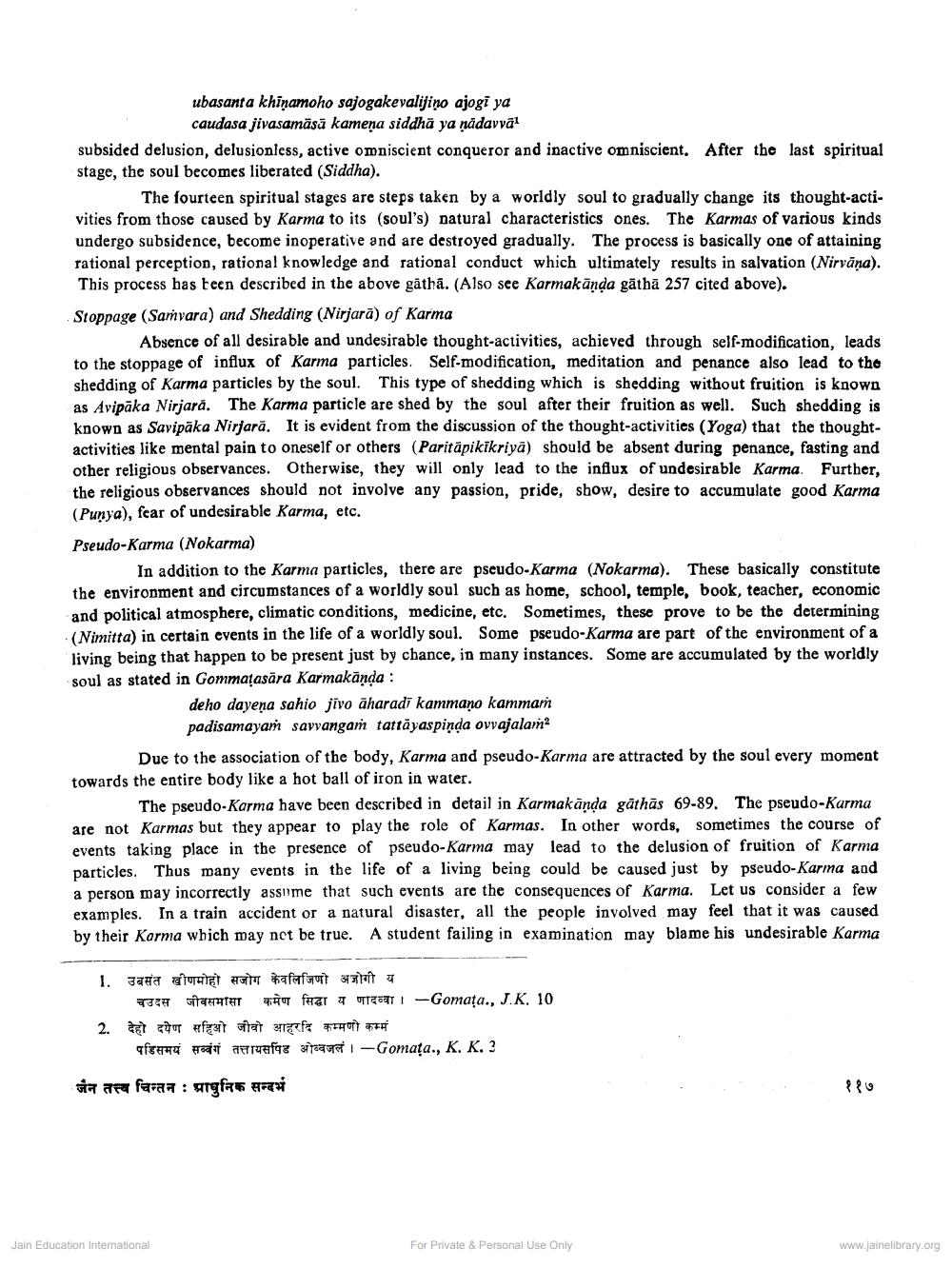Book Title: How Karma theory relates to Modern Science Author(s): Dulichand Jain Publisher: Z_Deshbhushanji_Maharaj_Abhinandan_Granth_012045.pdf View full book textPage 6
________________ ubasanta khinamoho sajogakevalifino ajogi ya caudasa jivasamāsā kamena siddha ya nädavväl subsided delusion, delusionless, active omniscient conqueror and inactive omniscient. After the last spiritual stage, the soul becomes liberated (Siddha). The fourteen spiritual stages are steps taken by a worldly soul to gradually change its thought-activities from those caused by Karma to its (soul's) natural characteristics ones. The Karmas of various kinds undergo subsidence, become inoperative and are destroyed gradually. The process is basically one of attaining rational perception, rational knowledge and rational conduct which ultimately results in salvation (Nirvāna). This process has teen described in the above gathā. (Also see Karmakānda gātha 257 cited above). Stoppage (Saṁvara) and Shedding (Nirjarā) of Karma Absence of all desirable and undesirable thought-activities, achieved through self-modification, leads to the stoppage of influx of Karma particles. Self-modification, meditation and penance also lead to the shedding of Karma particles by the soul. This type of shedding which is shedding without fruition is known as Avidāka Nirjară. The Karma particle are shed by the soul after their fruition as well. Such shedding is known as Savipāka Nirjarā. It is evident from the discussion of the thought-activities (Yoga) that the thoughtactivities like mental pain to oneself or others (Paritäpikikriyā) should be absent during penance, fasting and other religious observances. Otherwise, they will only lead to the influx of undesirable Karma. Further, the religious observances should not involve any passion, pride, show, desire to accumulate good Karma (Punya), fear of undesirable Karma, etc. Pseudo-Karma (Nokarma) In addition to the Karma particles, there are pseudo-Karma (Nokarma). These basically constitute the environment and circumstances of a worldly soul such as home, school, temple, book, teacher, economic and political atmosphere, climatic conditions, medicine, etc. Sometimes, these prove to be the determining (Nimitta) in certain events in the life of a worldly soul. Some pseudo-Karma are part of the environment of a living being that happen to be present just by chance, in many instances. Some are accumulated by the worldly soul as stated in Gommaļasāra Karmakānda : deho dayeņa sahio jivo āharadi kammaņo kammam padisamayam savvangar tattāyaspinda ovvajalama Due to the association of the body, Karma and pseudo-Karma are attracted by the soul every moment towards the entire body like a hot ball of iron in water. The pseudo-Karma have been described in detail in Karmakānda gāthās 69-89. The pseudo-Karma are not Karmas but they appear to play the role of Karmas. In other words, sometimes the course of events taking place in the presence of pseudo-Karma may lead to the delusion of fruition of Karma particles. Thus many events in the life of a living being could be caused just by pseudo-Karma and a person may incorrectly assume that such events are the consequences of Karma. Let us consider a few examples. In a train accident or a natural disaster, all the people involved may feel that it was caused by their Karma which may not be true. A student failing in examination may blame his undesirable Karma 1. उबसंत खीणमोहो सजोग केवलिजिणो अजोगी य 7 samar fear 21 -Gomata., J.K. 10 2. देहो दयेण सहिओ जीवो आहरदि कम्मणो कम्म aftuwa waajiri aruefaz part I -Gomața., K. K. ? जैन तत्त्व चिन्तन : प्राधुनिक सन्दर्भ Jain Education International For Private & Personal Use Only www.jainelibrary.orgPage Navigation
1 ... 4 5 6 7 8 9 10 11
